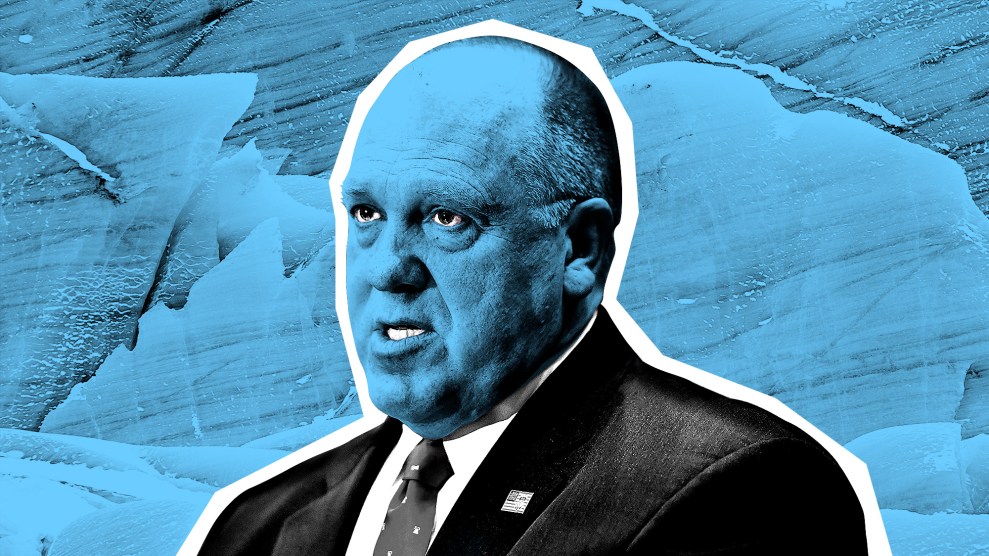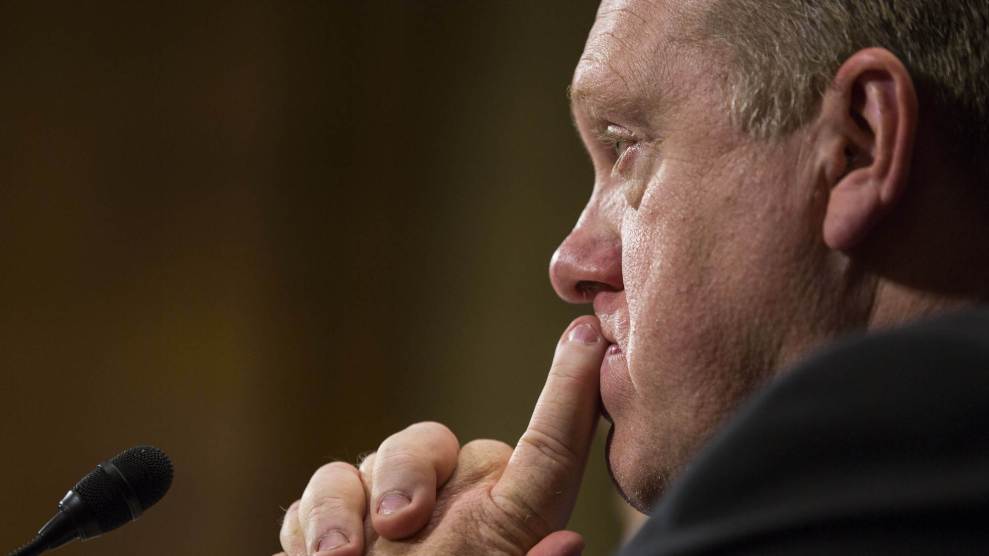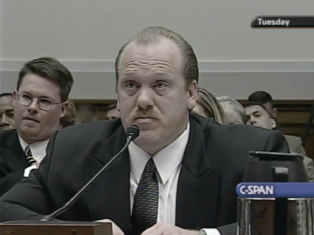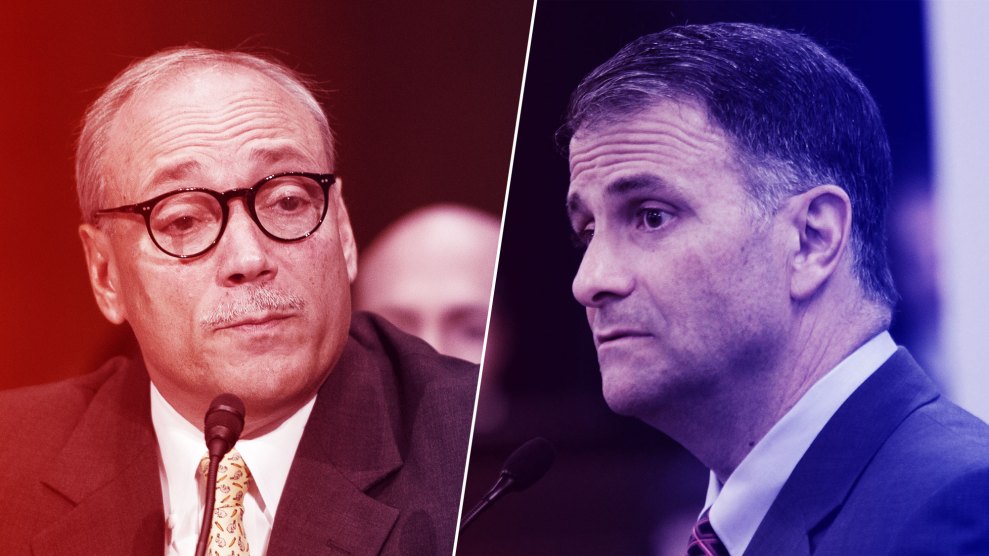
1. “He looks very nasty”
After 33 years in law enforcement, Thomas Homan retired last January for about three hours. As he was leaving his retirement ceremony on a Friday afternoon, Homeland Security Secretary John Kelly called to say President Donald Trump was offering a promotion. Homan came back to work on Tuesday as the acting director of US Immigration and Customs Enforcement.
From the outside, Homan might have seemed a surprising choice to lead ICE, a 20,000-person division of the Department of Homeland Security that deports more than 200,000 people per year. During the Obama administration, Homan had won the highest civil service award after effectively enforcing the more limited deportation priorities that Trump rose to power attacking. But Kelly appeared to know something that had long been clear to many of Homan’s colleagues: Homan did not like that the Obama administration had told his officers whom they should and shouldn’t arrest.
Since taking over as acting director of ICE, Homan has gone from being a mostly anonymous civil servant to one of the most combative defenders of Trump’s immigration agenda. He has appeared on Fox News to say that politicians who limit cooperation with ICE should be charged with crimes and has staged retaliatory operations against their cities in the meantime. ICE arrests were up 41 percent last year and 171 percent among people without criminal records. ICE is now pursuing even the most sympathetic undocumented immigrants. That is part of Homan’s goal. Testifying before Congress last year, he warned, “If you’re in this country illegally…you should be uncomfortable. You should look over your shoulder, and you need to be worried.”
Crucially for a president obsessed with appearance, Homan—a barrel-chested former cop—looks the part. His presence is imposing enough that two former colleagues said, unprompted, that they’d never seen him bully someone. In July, Trump said he’d heard that Homan looks “very nasty.” He replied, “That’s exactly what I was looking for.” Many of the 12 former colleagues of Homan interviewed for this article, from Arizona, Texas, and Washington, DC, say he has a soft side behind the gruff exterior. But that hasn’t stopped Homan from playing up his “cop’s cop” persona on TV, surely aware that it goes over well with his most important viewer.
His approach hasn’t won him many friends in immigrant communities. ICE has never been popular among immigrants, but outrage over its tactics has reached new heights. Homan is enthusiastically enforcing the immigration agenda of a president who began his campaign by accusing Mexico of sending “rapists” to the United States. ICE is now a stand-in for Trump’s anti-immigrant agenda as a whole, and Homan is the agency’s unapologetic defender.
Some of Homan’s former colleagues have been shocked by his recent rhetoric. Cecilia Muñoz, who ran the White House Domestic Policy Council under Obama and worked closely with Homan, says, “I find the Tom Homan that I see on TV now unrecognizable compared to the one that I saw in the Situation Room.” But there have been hints of the new Homan from the start. His rise helps explain the true character of an agency that, after a blip of restraint during the Obama administration, has returned to its roots as an unbending enforcer of immigration law and deporter of people who violate it. And as long as Homan remains in charge, undocumented immigrants in the country who may have felt safe before have good reason to be afraid.

Homan listening during a Senate hearing in February 2016.
Al Drago / Zuma
2. He was a “street guy”
Homan, 56, has compared the world he grew up in to Mayberry R.F.D., an Andy Griffith Show spinoff whose hokey intro features a dad playing catch in khakis. Homan’s father, Ted, received two Bronze Stars and a Purple Heart in World War II before returning to upstate New York. He settled in the village of West Carthage, about 30 miles south of the Canadian border, and worked as a part-time police officer and mechanic. Homan’s mother, Doris, worked at various times at a paper company and in two hospital cafeterias.
After graduating from what is now SUNY Polytechnic Institute in 1983 with a degree in criminal justice, Homan joined the village police force. A year later, he headed to Campo, California, 50 miles east of San Diego, to join the Border Patrol, which was part of what was then called the Immigration and Naturalization Service. At the time, immigration enforcement was not a top priority. In 1986, the FBI received about twice as much federal funding as the INS; now, immigration enforcement gets twice as much as the FBI.
Homan was promoted to a special agent position in Phoenix after seizing a record-breaking haul of nearly 1,300 pounds of cocaine from two smugglers in 1986, according to a 1988 article in the Carthage Republican Tribune, a local paper in upstate New York. Hank Woodrum, a former INS investigator in Arizona, remembers Homan, his hand-picked deputy, as a forceful presence. (He quickly adds that Homan never “browbeat” him.) Woodrum says Homan didn’t talk in those days of moving into the agency’s leadership in Washington, but he isn’t surprised that Homan excelled and recalls he was particularly good at keeping the rank and file in line.
When Homan transferred to Texas in 1999, Congress was in the process of dramatically increasing border security, an effort that reshaped migration patterns along the country’s southern border. Instead of coming and going for seasonal jobs, Mexicans were staying in the US to avoid increasingly dangerous and expensive journeys north. The result was a substantially larger permanent undocumented population that is now settled across the United States, according to research by Princeton sociologist Douglas Massey. Beyond being a “waste” of money, Massey found, the effort to secure the border likely led to more than 5,000 migrant deaths by 2010.
In 2003, Homan was called in to investigate that reality after Tyrone Williams, a dairy trucker, attempted to smuggle more than 70 Latino immigrants across Texas. As Williams drove through the night, the temperature in the trailer climbed above 110 degrees, Univision’s Jorge Ramos wrote in 2005. Nineteen people died, including a five-year-old boy. “That haunts me to this day because I had a five-year-old boy at the time,” Homan said last year, adding, “We got to end this stuff.” For Homan, the solution was tighter enforcement.

Homan testifies before a House committee in 2003. Credit:
CSPAN
The investigation began just after the INS’s enforcement responsibilities were split between two agencies: Customs and Border Protection and ICE, Homan’s new division. ICE was placed in charge of what is known as interior enforcement, which takes place away from the border, in cities like New York and Chicago. It’s the component of immigration enforcement that most often generates headlines for splitting up families that have been living in the United States for decades. A month after the trailer incident, Homan testified before Congress that ICE would “excel in interior enforcement” in a way that the “legacy INS was not allowed to.” He added that the government needed to stop “dangling this carrot of amnesty” because “as long as that carrot is being dangled, we’re going to continue having an immigration problem.”
At the time, it didn’t look like Homan would have much influence over ICE’s policies. Ken Cates, who worked as Homan’s boss in Dallas, says there are two kinds of agents: “street guys” and those who prefer to work in administration. He always took Homan for a street guy. Yet in 2006, Homan took a job in Texas overseeing internal investigations for the Transportation Security Administration. Three years later, he headed to Washington to help manage the logistics of detaining people at ICE. “When I saw that Tom had actually gone to headquarters, I was a little surprised, to be honest with you,” Cates says.
3. “Tom is brute force”
Alonzo Peña became ICE’s deputy director around the same time Homan got to headquarters. Peña, who knew Cates and Homan from Texas, says Homan was completely on board with the Obama administration’s decision to focus on deporting people with criminal histories. How well the prioritization worked in the early years of the Obama administration is intensely debated. Deportations of people with criminal records increased to record highs, but most people being deported either had no convictions or had committed crimes that ICE didn’t consider top priorities. Immigrant advocates labeled President Barack Obama the “deporter in chief,” and more “sanctuary” cities began limiting their coordination with ICE.
In November 2014, DHS overhauled its enforcement priorities, partly to help convince sanctuary jurisdictions to resume cooperating with immigration authorities. The new guidelines called for targeting people who had been been convicted of felonies or multiple misdemeanors, not those who had only been charged with a crime. After that, says David Leopold, a Cleveland-based immigration lawyer and the former president of the American Immigration Lawyers Association, “the fear was gone”—undocumented immigrants with no criminal record who were already living in the US had “almost no chance” of being deported. In Obama’s last year in office, 92 percent of people deported from the interior of the country had criminal convictions, compared to 53 percent at the end of the George W. Bush administration and 67 percent in 2011. Overall, interior deportations fell from about 223,000 in 2011 to 65,000 in 2016.
Homan helped develop the new priorities and played a key role in convincing thousands of skeptical ICE officers to enforce them. He won DHS Secretary Jeh Johnson’s admiration in the process, and in 2015, Homan received the Presidential Rank Award, the highest honor for civil servants. When Johnson left DHS, Homan was one of just a handful of people who spoke at the ceremony, according to a former DHS official who was at the event. Johnson declined to comment for this story.
Homan didn’t embrace every aspect of the new priorities. As arrests fell, Sen. Jeff Sessions (R-Ala.) pressed Homan to explain why his officers were waiting for undocumented immigrants to be convicted before detaining them. Homan smirked, bit his tongue, and said he wasn’t sure of his superiors’ reasoning. “I spent a lot of time, a lot of time, with Tom,” says one former DHS colleague. “Do I think Tom embraced [the priorities] fully? No.” The former DHS colleague says Homan would tell Johnson that he was focused on deporting the “worst first,” but it was clear he wasn’t fully on board. “Tom doesn’t do nuance,” the official says. “Tom is brute force.”
Homan sometimes referred to undocumented immigrants as “tonks” while he was in Washington, according to two former DHS officials interviewed by HuffPost. People familiar with the term say it is Border Patrol slang that comes from the sound made when hitting someone over the head with a flashlight or baton, HuffPost reported. Homan denied using the term and said he hadn’t heard it in years.
In 2015 and 2016, Homan surprised colleagues by pushing for less enforcement. As children from Central America were starting to show up alone at the border in unprecedented numbers, Congress pressured the White House to make good on its pledge to remove those who didn’t qualify for humanitarian protections. Muñoz, the Domestic Policy Council director at the time, says that when administration officials asked Homan to come up with the plan to do that, he resisted harsher enforcement measures.
Homan was “the person who made the most passionate argument against removing anybody,” Muñoz says. Muñoz had won a MacArthur “genius” grant for her work on behalf of immigrants, yet Homan was the one making the strongest case against arresting people who came to the US as minors. Homan, she recalls, said he didn’t want a repeat of the 2000 Elián González case, when a Cuban boy was taken from his Miami relatives at gunpoint. Homan says in a statement to Mother Jones that he didn’t think the arrests would have been “the best use of our limited resources.”
During the 2016 presidential contest, Homan kept his personal opinions about immigration policy to himself. When the Washington Post asked him in April 2016 what he thought about Trump’s aggressive immigration proposals, he replied, “Sorry, I can’t say what I think.” He wouldn’t keep his thoughts private for long.
4. “You’re talking about every immigrant in the country”
Five days into his presidency, Trump upended the Obama administration’s immigration enforcement strategy, stating in an executive order that no population of undocumented immigrants should be protected from deportation. Homan’s retirement party was two days later. He’d told colleagues that he was looking forward to leaving government and had lined up a job as a national security consultant at the accounting firm PricewaterhouseCoopers, which advises ICE and DHS. There wasn’t a sense at the party that his departure would be temporary, according to a source who was there. Homan appeared to be leaving a three-decade career in law enforcement with the respect of DHS colleagues on the left and right. (In interviews, his former colleagues describe him as blunt but willing to compromise.) Instead, he accepted Kelly’s offer, knowing full well what he was getting into. Trump’s executive order meant that ICE would soon be breaking apart many more families who had been in the US for decades.
The first major operation of Homan’s tenure led to more than 680 arrests, and about 75 percent of those arrested had criminal convictions. In what would become a familiar exercise, Kelly highlighted the ones who had been convicted of homicide and other severe offenses. Months later, the Intercept revealed that ICE officials had scrambled to find the most extreme cases. ICE’s acting head of removal operations told his staff to “put together a white paper covering the three most egregious cases” for Kelly. A subordinate in Texas wrote to his staff, “As soon as you come in, your sole focus today will be compiling three egregious case write-ups.”
In February 2017, Kelly implemented Trump’s executive order by eliminating the 2014 enforcement guidelines. Kelly told ICE officers that they should no longer exempt any group of undocumented immigrants from arrest. The memo vastly expanded ICE’s enforcement priorities by including people who had been only been charged with a crime. It also made people with a deportation order—many of whom had previously been spared—a priority target for ICE. And if officers came across immigrants who did not meet the priority criteria, they were told they could arrest them, too. As Homan said last year, “No population is off the table.”

Adi with his daughters in Youngstown, Ohio, in January.
Robert K. Yosay/AP
When immigrants are facing deportation, members of Congress may take the rare step of introducing a “private bill” to give them legal status. The bills usually don’t become law, but under the Obama administration, ICE didn’t deport people who were named in the bills. Homan often stepped in voluntarily to help legislators stop pending deportations. Yet in May, Homan announced that ICE would no longer delay deportations as a result of private bills. Instead, Homan said ICE would consider requests only from the House and Senate Judiciary Committees, which are controlled by Republicans known for their hardline views on immigration.
When Obama was president, Rep. Tim Ryan (D-Ohio) used a private bill to help prevent the deportation of Amer Othman Adi, a convenience store owner in his district who had come to the US from Jordan in 1979. But in January, ICE agents arrested Adi and placed him in immigration detention. “They went out of their way to humiliate him and his family,” says Ryan, who accompanied Adi to the meeting. A House judiciary subcommittee quickly voted across party lines to ask ICE to delay Adi’s deportation. ICE declined to issue a stay and deported Adi in late January.
“To watch Amer—who has four beautiful daughters, and a beautiful wife, and they are just all so in love with each other—and to watch him ripped away from them after 39 years in the United States is bullshit,” Ryan says. “It’s absolute bullshit.”
The extent of Homan’s transformation became clear in June, when he testified before Congress. Rep. David Price (D-N.C.) quoted a speech in which Kelly had told lawmakers to “shut up and support” immigration enforcers until Congress passed laws giving officers more discretion. When Price asked Homan how to do that, Homan implied that he wouldn’t support legislation that put any limits on whom ICE can arrest.
“By that standard, you’re talking about every immigrant in the country without papers,” Price interrupted.
Homan didn’t dispute that, saying, “As I said earlier, if you’re in this country illegally…you should look over your shoulder and you need to be worried.” After his response became headline news, he told CNN he had “zero regrets.” Homan tells Mother Jones that undocumented immigrants “should be uncomfortable” just as if they were driving illegally. “When you’re speeding down the highway,” he says, “you worry that you might get a ticket.”
Some ICE officers wanted an even more thorough crackdown on illegal immigration. Homan’s testimony didn’t stop Chris Crane, the combative head of ICE’s union, from telling Breitbart Texas in July that it “is a disgrace that the man who oversaw Obama’s effort to release criminal illegal aliens into our country is now the acting director of ICE.” Later that month, Homan took an even harder line, telling Fox News that politicians who limit cooperation with his officers may be breaking the law. In January, Homan made that threat explicit. “We gotta start charging some of these politicians with crimes,” he said during one of his frequent appearances on the network. Specifically, Homan said politicians were violating an alien smuggling statute passed by Congress in 1965.
Bill Hing, a law professor at the University of San Francisco, told Mother Jones the next day that anyone calling for prosecutions of sanctuary city politicians is “shooting from the hip” and doesn’t “know what they’re talking about.” Limiting information-sharing with ICE is “nowhere near” what the statute is designed to prohibit, Hing said. There’s no precedent for treating politicians like the human smugglers Homan once investigated in Texas. Homan says it’s up to lawyers at the Department of Justice to consider the legal questions. He adds, “As a law enforcement officer, my view is that people who knowingly shield individuals from federal immigration enforcement are violating the law.”
Cities and states don’t have to help ICE arrest inmates, so Homan needs them to be willing partners. The Obama administration eventually opted to negotiate with sanctuary cities on an individual basis to get them to turn over people with serious criminal convictions—what Muñoz calls the “axe murderers.” Muñoz says that’s been completely disrupted by Homan and Trump’s rhetoric. “What I find really interesting is watching him overturn what I know he knows to be true,” she says. “Which is that collaboration, even under a set of rules that he might find too restrictive, is better than no collaboration at all.” The more Homan attacks sanctuary jurisdictions, the less likely they are to cooperate, and the two sides grow ever more entrenched in their stances.
The pattern is clearest in California, which passed legislation last year that limits cooperation with ICE. In response, Homan vowed to “significantly increase” ICE’s presence in the state. He’s made good on that promise by launching highly publicized operations in the Bay Area, Los Angeles, and San Diego, in which hundreds of people have been arrested this year. (The Justice Department is also suing California.)
When Oakland Mayor Libby Schaaf warned residents about impending arrests in February, Homan told the hosts of Fox & Friends that Schaaf was no better than a “gang lookout.” He said Schaaf had intentionally placed his officers at risk and prevented ICE from arresting 800 people, even though he’d previously said he wasn’t sure how many people Schaaf helped evade arrest. It was clearly an exaggeration: ICE had an additional 800 people on its target list, but there was no way it would find all of them in a single sweep. ICE’s San Francisco spokesman James Schwab told the San Francisco Chronicle that he was directed by superiors not to correct the misstatements from Homan and Attorney General Jeff Sessions. He resigned in protest and said, “I’ve never been in a situation when I’ve been asked to ignore the facts because it was more convenient. It was my first time being asked to do that.”
What is motivating attacks on sanctuary cities that are so obviously poised to backfire? Part of the answer has to do with Homan’s concern for his team. When ICE can’t arrest people in the relative safety of a jail because a sanctuary city or state prohibits it, officers often try to arrest them at their homes instead. Homan has said his officers don’t know who’s behind those doors and that it’s only a matter of time before one of his officers is killed. Former colleagues stress that Homan is intensely loyal to his officers, and nothing appears to frustrate him more than the danger he believes sanctuary policies put them in. Five ICE officers have died doing their jobs since the agency was created, HuffPost reports, and no deportation officers have been killed in violent altercations with undocumented immigrants, according to the National Law Enforcement Officers Memorial Fund.
Homan is also battling longstanding problems with morale. Job satisfaction at ICE ranked 299 out of 305 federal agencies in 2016, according to the nonpartisan Partnership for Public Service. Last year, satisfaction rose more than at any other agency. Homan told the Washington Examiner in July that his employees now “have meaning to their jobs.”
But former colleagues say Homan is doing more than just sticking up for his staff. Peña, the former ICE deputy director, says it’s “a heck of a title to be director of Immigration and Customs Enforcement.” Getting that title is the best explanation he can think of for Homan’s rhetoric. Muñoz says that like other administration officials, Homan clearly recognizes “that when he’s on television, the president of the United States is likely watching, and his job may depend on him saying what he believes the president wants to hear.” In November, Trump selected Homan to be ICE’s permanent director. A Senate staffer familiar with the matter says Homan’s nomination is stalled until the White House submits biographical information to the Senate Homeland Security Committee. It’s not clear when the White House will try to advance Homan’s nomination, the staffer says.
Peña says there’s one other possible reason for Homan’s shift. Immigration enforcement, he says, “has become very profitable for some people” in the private detention business. He adds, “There certainly would be a look by some of these companies that are making huge profits at somebody like Tom when he retires.” Daniel Ragsdale, who preceded Homan as acting ICE director, now works for GEO Group, America’s second-largest private prison and detention company. In response to a question about a possible future for Homan in the detention industry, Liz Johnson, an ICE spokeswoman, says Homan “chose to pass up an opportunity in the private sector in order to continue serving his country at the request of the president of the United States.”
5. Padding the numbers
Homan and Trump had an immediate and dramatic impact on the way ICE operates. ICE arrested about 155,000 people last year, up from 110,000 in 2016, and arrests of people without criminal records nearly tripled, from 17,000 to 46,000. Even the people who had committed crimes were not always the clear threats ICE made them out to be. The four most common convictions among people ICE arrested last fiscal year were DUIs, other traffic offenses, drug-related charges, and immigration violations.
ICE press releases feature a parade of murderers and gang members. Homan said in August, “The question is always asked, ‘Do illegal immigrants commit more crimes than U.S. citizens?’ I don’t know.” But finding the answer doesn’t seem particularly important to him; he said in the same interview, “Every crime an illegal alien commits wouldn’t have been committed if he wasn’t here.” In 2015, there were 1,749 criminal convictions in Texas for every 100,000 native-born Americans—more than twice the rate for undocumented immigrants and nearly seven times the rate for legal immigrants, according to an analysis by the libertarian Cato Institute.
The agency previously allowed many undocumented immigrants with deportation orders to remain in the country if they agreed to meet regularly with ICE officers. ICE now frequently arrests people at those check-in meetings—people who John Sandweg, who briefly served as ICE’s acting director under Obama, says tend to have the strongest case for remaining in the US.
George Escobar, the head of social services for the immigrant advocacy group CASA de Maryland, cites the case of two brothers from Maryland. Lizandro Claros Saravia, a 19-year-old soccer star, and 22-year-old Diego received deportation orders during the Obama administration but were spared deportation as long as they met regularly with ICE officers. Last year, they were detained at what they thought would be a routine check-in with ICE. CASA provided legal services and helped generate national media attention, but it wasn’t enough. The brothers were quickly deported to El Salvador. Sandweg says that for ICE, people who were allowed to stay in the US after receiving a deportation order are “low-hanging fruit” who can be deported easily. “It’s pad the numbers,” he says.
Interior deportations haven’t increased as quickly as arrests. Overtaxed immigration courts already have a nearly 700,000-case backlog, and Sandweg says it will take longer to deport people without criminal records. ICE is still deporting far fewer people than it once did: about 81,000 people from the interior of the country last fiscal year, compared to roughly 230,000 per year between 2008 and 2011. Homan thinks he can get back to the deportation record set in 2012, when nearly 410,000 people were deported from the interior and border regions. “I think we’re going to get there,” he told the Washington Times in July. “Our interior arrests will go up.” To accomplish that, he pledged last year to increase enforcement at workplaces by four or five times. Last week, ICE arrested 97 immigrants at a meat processing plant in Tennessee in what immigrant advocates say is the largest workplace raid since the Bush administration.
Homan is also pushing to keep more immigrants in detention. ICE already detains about 40,000 people per day—18 times more than INS even had the capacity to detain in 1989. The Trump administration wants the number to exceed 50,000 per day, but Congress has refused to provide the funding so far. In 2016, Homan signed a letter stipulating that pregnant women would be detained only when it was mandatory or there were “extraordinary circumstances.” But in December, he instituted a new policy of deciding on pregnant women’s detention on a case-by-case basis.
Homan disputes the idea that he’s changed. “Certainly, now that I’m in a leadership position, I’m able to share my views more vocally,” he says. “But I’m still the guy who pushed hard for broader enforcement priorities in the last administration beyond just convicted criminals.” Muñoz disagrees, saying there’s a dramatic difference between the thoughtful discussions they had with other Obama administration officials about immigration enforcement and “going on television and displaying the kind of attitude and approach that Tom has been doing since assuming this position.”
For Peña, putting all undocumented immigrants at risk of deportation is a massive waste of resources. “Why are you going to clog up the limited bed space you have with a mother or a grandmother who happens to have overstayed her visa?” he asks. Cates, who worked with Peña in the 1970s, sees it differently. He says the law tells Homan to deport undocumented immigrants, and Congress should pass new laws if it doesn’t want him to do that. “Cops are not here to make those sociological distinctions,” he says. “We’re here to enforce the law.” Homan said in January that all of the president’s executive orders on immigration can be summed up in one sentence: “You will now enforce the laws enacted by Congress.”
The biggest shift under Trump may be the one that’s hardest to measure: widespread fear. Undocumented immigrants now know that no matter how long they’ve been in the US—or even if they have children who are US citizens—the Trump administration will not hesitate to deport them. Escobar, who has worked with immigrants for the past 15 years, says there was finally a sense that immigration enforcement was being handled rationally at the end of the Obama administration. Now, immigrants face arrests that often seem designed to create a feeling of chaos, he says.
Homan argued last year that he has been conducting “targeted enforcement operations” rather than rounding up immigrants at random, even though ICE officers now often arrest people who are not on their target lists. He said that the media and politicians were the ones stoking fear by mischaracterizing ICE’s enforcement strategy.
Muñoz doesn’t buy it. “Of course they’re instilling fear,” she says. “At some level that’s the nature of the job. The question is whether you leverage it intentionally or not.” She doesn’t hesitate when asked about the levels of fear the current approach has created among undocumented immigrants. “They’re unlike anything I’ve ever seen,” she says, “and I’ve been doing this for 30 years.”
Image credit: Kevin Dietsch/AP; brytta/Getty











